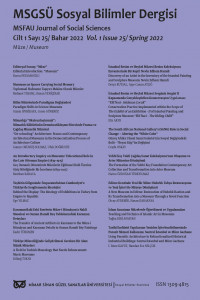19. Yüzyıl Osmanlı Müziği Bağlamında Batı Nota Yazısı
19. yüzyılda Osmanlı sanat müziğinin icra repertuarı, farklı nota yazım teknikleri kullanılarak çok sayıda kaynakta kaydedilmiştir. Hamparsum notasyonunun semantiği iyi çalışılmış olsa da yaklaşık 1830'dan 1880'e kadar olan dönemde Osmanlı müziği bağlamında Batı notasyonunun kullanımı üzerine karşılık gelen bir çalışma yoktur. Bu makale, nota karşılaştırmaları temelinde Batı nota yazısını kullanan 19. yüzyıl Osmanlı müzik el yazmalarının yorumlanmasına yönelik bir yaklaşım geliştirmektedir. Çalışmaların sonuçları halihazırda anlamsal olarak doğru bir transkripsiyona izin vermektedir, ancak her şeyden önce daha fazla araştırmayı teşvik etmeyi amaçlamaktadır.
Anahtar Kelimeler:
Osmanlı Müziği, Batı Nota Sistemi, Müzik El Yazmaları, Semantik
Western Staff Notation in the Context of Nineteenth-Century Ottoman Music
In the 19th century, the performative repertoire of Ottoman art music was recorded in numerous sources using different notation techniques. While the semantics of Hampartsum notation has been well studied, there are no corresponding studies on the use of Western staff notation in the Ottoman music context in the period from about 1830 to 1880. This paper develops an approach to the interpretation of 19th-century Ottoman music manuscripts using Western staff notation on the basis of notational comparisons. The results of the studies already allow for a semantically correct transcription, but above all, they are intended to stimulate further research.
Keywords:
Ottoman Music, Western Notation System, Music Manuscripts, Semantic,
___
- Alimdar, S. (2016). Osmanlı'da Batı müziği. İstanbul: Türkiye İş Bankası Kültür Yayınları.
- Aracı, E. (2006). Donizetti Paşa. Osmanlı sarayının İtalyan maestroso. İstanbul: Yapı Kredi Yayınları.
- Ayangil, R. (2008). Western notation in Turkish music. Journal of the Royal Asiatic Society of Great Britain & Ireland, 18(4), 401 - 447.
- Behar, C. (1990). Ali Ufkî ve mezmurlar, İstanbul: Pan Yayıncılık
- Corpus Musicae Ottomanicae (CMO) Editions. Retrieved March 15, 2023, from https://www.uni-muenster.de/CMO-Edition
- Corpus Musicae Ottomanicae (CMO) Source Catalog. Retrieved March 15, 2023, from https://corpus-musicae-ottomanicae.de/content/index.xml.
- Çolakoğlu-Sarı, G., & Güner, B. (2019). Tasnif ve tespit heyeti üyesi Ali Rifat Çağatay. In Nilgün Doğrusöz (Ed.). Ali Rifat Çağatay arşivi II 'Makaleler'. (pp. 32-55). İstanbul: İTÜ OTMAG Yayını.
- Dahlhaus, C. (1989). Die Musiktheorie im 18. und 19. Jahrhundert. Zweiter Teil Deutschland (R.Müller, Ed.). Darmstadt: Wissenschaftliche Buchgesellschaft.
- Erol, M. (2003). Türkçe matbu nota ve solfej kitabı: Hacı Emin Efendi ve “Nota Muallimi” (1885). Müteferrika, Sayı 23, pp. 103-140. Retrieved March 5, 2023, from https://www.academia. edu/6818446/T%C3%BCrk%C3%A7e_Matbu_Nota_ve_Solfej_Kitab%C4%B1_Hac%C4%B1_ Emin_Efendi_ve_Nota_Muallimi_1885_.
- Gazimihal, M. R. (1955). Türk askerî muzıkaları tarihi. İstanbul: Maarif Vekaleti .
- Emin, N. H. M. (1884). Nota muallimi. İstanbul: Zartaryan Matbaası (Numara 14).
- Haug, J. I. (2019) Ottoman and European music in ʿAlī Ufuḳī's compendium, MS Turc 292: Analysis, interpretation, cultural context. Münster: Wissenschaftliche Schriften der WWU Münster Reihe XXVI, Writings in Musicology from Münster Volume 25. Retrieved 08 April 2023 from https://nbn-resolving.org/urn:nbn:de:hbz:6-26119679676.
- Jäger, R. M. (2011). Der Beginn der wissenschaftlichen Erforschung osmanischer Kunstmusik im Europa der Aufklärung. In B. Schmidt-Haberkamp (Ed.), Europe and Turkey in the 18th century (pp. 473-488). Bonn: Bonn University Press.
- Pelen, S. (2021). CMO1-I/11.16 Beste-nigār Nuʿmān Aġa'nıñ devr-i kebīr, Transcription and Critical Report. Codex TR-Iüne 214-12: Transcriptions/Critical Reports [Preprint volume]. Münster: Corpus Musicae Ottomanicae. Retrieved 3 March 2023 from https://corpus-musicae-ottomanicae.de/receive/cmo_mods_00000740).
- Toderini, G. (1787). Letteratura turchesca I. Venice: Presso Glacomo Storti MDCCLXXXVII.
- Tuğlacı, P. (1986). Mehterhane'den bando'ya-Turkish bands of past and present. İstanbul: Cem Yayınevi.
- Yekta, R. (1922). La musique Turque. In L. Laurence (Ed.), Encyclopédie de la musique et dictionnaire du conservatoire, (Vol. 5), (pp. 2945-3074). Paris: Librairie Delagrave.
- ISSN: 1309-4815
- Yayın Aralığı: Yılda 2 Sayı
- Başlangıç: 2010
- Yayıncı: Mimar Sinan Güzel Sanatlar Üniversitesi
Sayıdaki Diğer Makaleler
Ottoman Greeks who Studied and Transcribed Ottoman Turkish Music: The Case of Nilevs Kamarados
Challenges and New Insights in the Critical Edition of the Persianate Repertoire in Ottoman Music
Materyal, Kuram ve Tatbik Çerçevesinde Nazife Aral-Güran Kişisel Arşivi
Representing the Sung Poetry of Ottoman Art Music in a Critical Digital Edition in TEI XML
